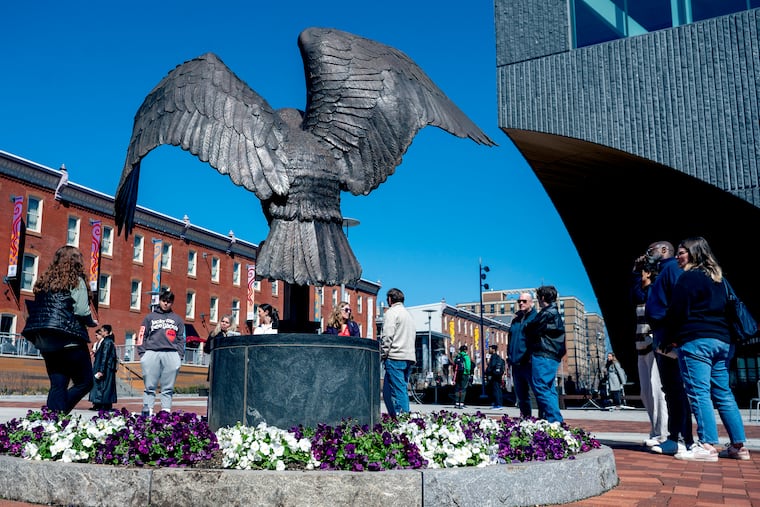We surveyed 20 local universities about enrollment. Here’s what they’re seeing.
Some colleges are continuing to recover pandemic enrollment losses, but most still aren't back to their 2019 levels. Temple had one of the biggest losses, while Eastern showed one of the biggest gains

Enrollment numbers in the fall are a harbinger of higher education health. The more students that enroll means more resources to grow; fewer signifies the need to do business differently, as many schools have had to do in recent years.
So what does local college enrollment look like a month into the school year?
» READ MORE: Here are fall 2022 enrollment numbers for Philly-area colleges and universities
From queries to 20 schools with more than a 50% acceptance rate (two of which didn’t respond), we found:
Less than half reported their freshmen numbers were higher than pre-pandemic levels in 2019.
Fourteen saw an increase in transfer students from last year, but only half of those schools were up from 2019, several noting the impact from the decrease in community college enrollments.
For overall enrollment, slightly more than half were up from last year.
And only four — Rowan and Rutgers-New Brunswick in New Jersey, Thomas Jefferson in Philadelphia, and Eastern University in St. David’s — said their enrollment had exceeded 2019.
» READ MORE: Enrollment at area colleges is increasing, although many still aren’t at pre-pandemic levels
Here are some other standout takeaways from these preliminary numbers:
Eastern saw a doubling of enrollment
Eastern led the way, reporting a doubling since 2019, from 3,059 students to 6,112, largely due to its low price “life flex” online programs that have boosted graduate and undergraduate enrollment. Its MBA, for instance, can be attained in 10 months for $9,900. The school also this year added undergraduate life flex degrees in business, education, psychology, and liberal arts, for as little as $2,500 to $7,500 a year, Eastern says on its website.
The university also noted its addition of football, cheer, dance, and esports teams over the last several years, with plans to launch a marching band next year.
Half of Eastern’s traditional undergraduate students are involved in athletics, school officials said.
Lower enrollment may be ‘the new norm’
But for many schools, returning to post-pandemic undergraduate enrollments may not be in reach, at least not in the immediate future, given that another dip in high school graduates is anticipated in 2025.
“This is the new norm,” said Francesca Reed, vice president of enrollment management and marketing at Neumann University. “We weren’t anticipating coming back to pre-pandemic levels [for undergraduate students]. I think that is unrealistic given the landscape.”
The university really is looking for graduate and adult enrollments to grow, she said. Neumann saw a 17% increase in new graduate students this year, she said.
Temple saw one of the biggest drops
Temple University in Philadelphia saw one of the largest declines in enrollment and was down in virtually every category: freshmen, transfers and overall. That continues a multiyear decline, leaving the university this year with an overall enrollment, including undergraduate, graduate, and professional students, of 30,530, down 9.2% from last year and 22% from 2019.
The school has 3,801 freshmen down 19.1% from last year and 23.5% from fall 2019. And its transfer enrollment, at 1,008 this year, is down by 18.1% from last year and 54.4% from fall 2019.
The enrollment numbers follow a particularly difficult year at Temple, which included the resignation of its president, a six-week graduate student worker strike, and the shooting death of an on-duty Temple police officer, reigniting safety concerns. Temple officials have noted in the past that safety concerns in its North Philadelphia neighborhood have led to some of the drop.
“We are still in the process of studying what led to our outcomes,” the university said in a statement. “On a positive note, we enrolled the most racially and ethnically diverse class in our recorded history.”
The university also last Tuesday suffered the sudden death of its acting president, JoAnne A. Epps.
» READ MORE: Temple’s acting president, JoAnne A. Epps, has died after falling ill on stage at university event
Rutgers sees a small decline
At Rutgers’ three campuses, including its main campus in New Brunswick and its Newark and Camden campuses, enrollment was down 4.7% from 2019. That’s less than a quarter of the percentage drop that Temple experienced. Preliminary numbers show enrollment at Rutgers this year at 67,672.
Rutgers-Camden was up 14.7% in freshmen from 2022, but down 21.4% or 157 freshmen from 2019. Overall at Rutgers-Camden, enrollment is down from both last year, 1.2%, and from 2019, 20.5% or 1,476 students.
On the positive side, the university noted its graduate student enrollment is up 21.9% from 2019.
La Salle finds silver lining in improved retention rate
La Salle said it had been preparing for and forecasting a smaller freshman class, but noted that it also accepted a smaller percentage of students. The university did not provide exact numbers.
“We continued to focus on engaging with students who were best prepared to persist and succeed at La Salle,” said spokesperson Angela Polec. “This strategy led to a two percentage-point increase in our first-to-second-year retention rate.”
La Salle also anticipates a smaller overall enrollment, too. Last year, the university’s enrollment stood at about 4,000, down from nearly 5,200 in spring 2019.
Polec noted that one program seeing an increase is nursing. Given the nursing shortage, the university saw a 50% uptick in first-year nursing students, she said.
We’ll be going back to universities for final enrollment numbers in October.